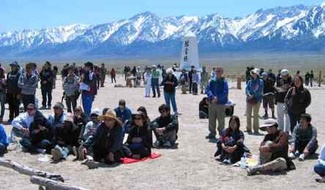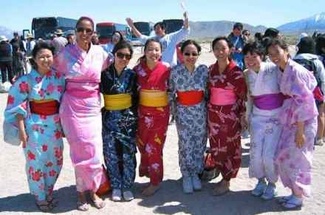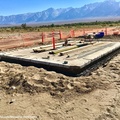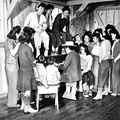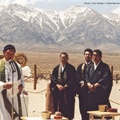After a long, exhausting day at the 42nd Annual Manzanar Pilgrimage on April 30, and the Manzanar At Dusk (MAD) program that evening, the Manzanar Committee is back at our headquarters hotel, the Dow Villa in Lone Pine, California, about eight miles south of the Manzanar National Historic Site, finally getting some rest after a whole lot of hard work on Saturday.
That is, everyone but yours truly.
Indeed, after running around all morning and afternoon at the Pilgrimage, and then running the Manzanar At Dusk program that evening, sleep is not foremost on my mind, even though it probably should be as I face a long drive home on Sunday.
No, sleep will have to wait a bit on this night, because after what happened on Saturday, I am compelled to reflect and express what is on my mind and in my heart.
We had a wonderful Pilgrimage on Saturday afternoon, honoring fallen community heroes Frank Emi, William Hohri and Fred Korematsu, and another who is certainly still alive and kicking…Aiko Herzig-Yoshinaga, one of my personal heroes and mentors.
But for me, both personally, and for the Manzanar Committee, not to mention the Japanese American community, the most important thing about the Pilgrimage is the involvement of young people in our community, as they are our future leaders, and, in many ways, they are among our current leaders…more on that later.
As such, it pleases me to no end that UCLA Kyodo Taiko performed at the Pilgrimage once again this year. They are always a big hit, and they have a unique ability to energize the crowd. My thanks to all the members of UCLA Kyodo Taiko, especially co-directors Samantha Ho and Masumi Asahi, for a wonderful performance!
omething new this year…those of you who attended the Pilgrimage probably noticed several women dressed in traditional Japanese yukata. These women were members of the UCLA Nikkei Student Union’s Odori dance group, who led us in the ondo dancing this year. Thank you NSU Odori, and especially to co-directors Jaymie Takeshita and Jamie Yabuno.
As for the Manzanar At Dusk program on Saturday evening, I emceed the program for the first time, which is a bit difficult for me to believe, since I’ve been the co-coordinator for the program for several years now. But that is not what is foremost on my mind. Rather, our community’s future is on my mind, and pride is what’s in my heart. Lone Pine Unified School District and Lone Pine High School. They co-sponsor MAD each year, providing use of the gymnasium and other facilities at the high school at no cost, except for the janitor’s salary that day. The Manzanar Committee certainly appreciates this support and thanks LPUSD and LPHS for their generosity, year after year.
If you attended the MAD program on Saturday, and especially if you’ve attended the program the last few years, you probably noticed that the program was a bit different this year, as students took on a much greater role.
At MAD, attendees want to hear the stories of the former concentration camp prisoners in attendance. In fact, year after year, this is the feedback we get from MAD participants, that they want to hear more of these stories first-hand.
Sadly, we will not have that luxury for long, as these honored people in our community are not getting any younger, and we have already lost many. That fact became all too clear at last year’s MAD program, as we did not have enough former prisoners for all of our small group discussions. That meant that it was time to come up with another way to keep those stories alive. But how?
Meanwhile, something I had been planning for years was to return the MAD program to its 1997 roots, when college students, along with Jenni Kuida and Ayako Hagihara of the Manzanar Committee, held the first MAD program around a fire at a campground just west of Independence, about six miles north of the Manzanar National Historic Site. Jenni and husband Tony Osumi had attended the Tule Lake Pilgrimage, where they have an interactive component in which participants could discuss what they had learned, and listen to the stories of the former prisoners in attendance. Inspired by that, Osumi thought that doing some kind of interactive program should be a part of the Manzanar Pilgrimage, and that is how the MAD program, known then as Manzanar After Dark, got its start.
In ensuing years, the program grew, and moved to the Veterans of Foreign Wars Hall in Independence, and then, in 2007, to the Interpretive Center at the Manzanar National Historic Site. But we drew a record crowd that year, filling the Interpretive Center past capacity (think “sardine can”). We knew that we needed a larger venue.
Since 2008, the Manzanar Committee has been fortunate to have the support of the Lone Pine Unified School District and Lone Pine High School. They co-sponsor MAD each year, providing use of the gymnasium and other facilities at the high school at no cost, except for the janitor’s salary that day. The Manzanar Committee certainly appreciates this support and thanks LPUSD and LPHS for their generosity, year after year.
But I digress…
*This article was originally published on May 1, 2011 on the Official Blog of the Manzanar Committee.
© 2011 Gann Matsuda


